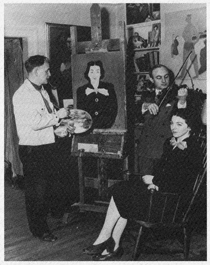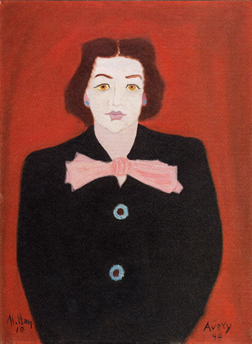The Seafarer (Booth, 222 W. 45). What’s the Broadway show to see if you’re only seeing one? I strongly recommend Conor McPherson’s uncommonly powerful fantasy about an unhappy Irishman (David Morse) who swears off the booze and finds himself standing face to face with the Divvil Himself. “The stuff of greatness,” say the posters. “Do not miss this play!” Yes, that’s what I wrote in The Wall Street Journal, except for the gratuitous exclamation point, and I meant every word (TT).
Archives for December 18, 2007
BOOK
David Parkinson, The Rough Guide to Film Musicals (Rough Guides, $14.99 paper). A decently written, unexpectedly sensible primer that walks you through the long and winding road that leads from The Jazz Singer to Chicago. Some films are undervalued, others overrated, but for the most part Parkinson plays it down the center, steering clear of the twin ditches of academic theory and camp silliness. If Sweeney Todd has you wondering whether there’s more to the genre than Busby Berkeley, this is a good place to find out what it’s all about (TT).
CD
Bill Evans, Conversations With Myself. Looking for the perfect Christmas present, either for yourself or someone you love? Try this classic 1963 album, on which the most influential jazz pianist of the postwar era overdubbed himself–twice. Listen to Evans Nos. 1, 2, and 3 playing Alex North’s “Love Theme from Spartacus” and see if the hair on the back of your neck doesn’t stand straight up. That was the first Bill Evans track I ever heard, and the impression it made on me back in high school has yet to fade (TT).
DVD
Get Carter. No, not the pointless Sylvester Stallone remake, but the original diamond-hard 1971 neo-noir masterpiece in which Michael Caine is out for revenge and doesn’t care who gets hurt along the way. After making this astonishing film, Mike Hodges dropped off the scope for three decades of mostly unmemorable slogging, only to resurface in 1999 with the similarly gripping Croupier. If you liked Croupier, what are you waiting for? (TT).
TT: Present and accounted for
 Regular readers of this blog will recognize the name of Louis Kaufman, the great American violinist and art collector who made the first long-playing recording of Vivaldi’s Four Seasons, played on the soundtracks of Gone With the Wind, The Adventures of Robin Hood, The Best Years of Our Lives, and Psycho, performed with Aaron Copland, Francis Poulenc, and Darius Milhaud, bought the first painting that Milton Avery ever sold, and wrote a delightful memoir called A Fiddler’s Tale: How Hollywood and Vivaldi Discovered Me. Alas, I never met Kaufman–he died in 1994 at the age of eighty-eight–but I’ve been corresponding with Annette, his wife and accompanist, for the past couple of years, and on Sunday I had the honor of showing her the Teachout Museum and taking her to lunch.
Regular readers of this blog will recognize the name of Louis Kaufman, the great American violinist and art collector who made the first long-playing recording of Vivaldi’s Four Seasons, played on the soundtracks of Gone With the Wind, The Adventures of Robin Hood, The Best Years of Our Lives, and Psycho, performed with Aaron Copland, Francis Poulenc, and Darius Milhaud, bought the first painting that Milton Avery ever sold, and wrote a delightful memoir called A Fiddler’s Tale: How Hollywood and Vivaldi Discovered Me. Alas, I never met Kaufman–he died in 1994 at the age of eighty-eight–but I’ve been corresponding with Annette, his wife and accompanist, for the past couple of years, and on Sunday I had the honor of showing her the Teachout Museum and taking her to lunch.
 Annette Kaufman is ninety-three years old, but you wouldn’t guess it to look at her–or talk to her. Not only is she still easily recognizable as the same woman who sat for Avery six decades ago, but she is a lively, bustling raconteuse who continues to consume art by the carload (she flew to New York from her Los Angeles home to see Prokofiev’s War and Peace at the Met). Judging by our conversation, she remembers everything she’s seen or heard with a clarity not even slightly diminished by age. I’d been careful to ask whether she could climb the stairs to my third-floor apartment, but it turned out that I was wasting my breath. Not only did she negotiate both flights of stairs with near-arrogant ease, but she took a cab straight from the Upper West Side bistro where we ate omelettes aux fines herbes to the Pissarro retrospective at the Jewish Museum. Spending three hours in her company made me feel…well, lazy.
Annette Kaufman is ninety-three years old, but you wouldn’t guess it to look at her–or talk to her. Not only is she still easily recognizable as the same woman who sat for Avery six decades ago, but she is a lively, bustling raconteuse who continues to consume art by the carload (she flew to New York from her Los Angeles home to see Prokofiev’s War and Peace at the Met). Judging by our conversation, she remembers everything she’s seen or heard with a clarity not even slightly diminished by age. I’d been careful to ask whether she could climb the stairs to my third-floor apartment, but it turned out that I was wasting my breath. Not only did she negotiate both flights of stairs with near-arrogant ease, but she took a cab straight from the Upper West Side bistro where we ate omelettes aux fines herbes to the Pissarro retrospective at the Jewish Museum. Spending three hours in her company made me feel…well, lazy.
In her youth Mrs. Kaufman was a wonderfully elegant and sensitive pianist, as you can hear for yourself on the bonus CD bound into A Fiddler’s Tale. Nowadays she’s too busy giving away the Louis and Annette Kaufman Collection to play much piano, but I have no doubt that if circumstances required her to do so, she could toss off the keyboard part to a Mozart violin sonata with the same casual grace that she brings to her reminiscences of the famous musicians, writers, and painters whom she and her husband knew. “A very interesting man,” she said when I showed her “Apples on a Table,” my 1923 Marsden Hartley lithograph. “Louis and I met him one day in Milton’s studio.” I did my best not to goggle.
I took it upon myself to suggest that Mrs. Kaufman pay a visit to the Martin Puryear show currently on display at the Museum of Modern Art, which felt a bit like offering advice to my grandmother on how to suck eggs. Be that as it may, she snapped up my recommendation with what I gather is her customary enthusiasm. “I just joined MoMA!” she replied. “That means I can take a friend with me!”
I also told her about The Letter, only to learn that she’s been going to Santa Fe Opera every August since shortly after I was born.
“That’s perfect timing,” I said. “The premiere is on August 1, 2009.”
“I’ll be there,” she replied.
I don’t doubt it.
TT: Almanac
Deck us all with Boston Charlie,
Walla Walla, Wash., an’ Kalamazoo!
Nora’s freezin’ on the trolley,
Swaller dollar cauliflower alley-garoo!
Don’t we know archaic barrel
Lullaby Lilla Boy, Louisville Lou?
Trolley Molly don’t love Harold,
Boola boola Pensacoola hullabaloo!
Walt Kelly, Deck Us All With Boston Charlie
